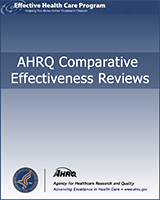1. Benefits*
3. Benefits among population subgroups† |
Randomized, double-blind, placebo controlled trials of tamoxifen, raloxifene, or tibolone for breast cancer prevention. Head-to-head trials that include direct comparisons between tamoxifen, raloxifene, or tibolone. Trials report breast cancer results as primary or secondary outcomes. ‡Trials enroll women without pre-existing breast cancer and can include women of all ages, pre or postmenopausal status, hysterectomy or nonhysterectomy status, US and non US. English language publications.
|
Non RCT study designs. Non breast cancer prevention studies. Women with pre-existing breast cancer, known precursor conditions, or known carriers of breast cancer susceptibility mutations (BRCA1, BRCA2, or others). Drugs other than tamoxifen, raloxifene, or tibolone. No breast cancer results as primary or secondary outcomes. Laboratory or animal studies. Non-English language publications.
| ≥3 months
≥100 participants | Primary or secondary breast cancer outcomes; other benefits defined by key question 1. |
2. Harms§
3. Harms among population subgroups† |
Randomized, double-blind, placebo controlled trials of tamoxifen, raloxifene, or tibolone. Head-to-head trials that include direct comparisons between tamoxifen, raloxifene, or tibolone. Observational studies that report results for women using tamoxifen, raloxifene, or tibolone and compares results to a nonuser group or compares results between these drug use groups. Studies enroll women without pre-existing breast cancer and can include women of all ages, pre or postmenopausal status, hysterectomy or nonhysterectomy status, US and non US. English language publications.
|
Women with pre-existing breast cancer, known precursor conditions, or known carriers of breast cancer susceptibility mutations (BRCA1 BRCA2, or others). Drugs other than tamoxifen, raloxifene, or tibolone. No harms results. Intermediate outcomes rather than health outcomes. ‡Laboratory or animal studies. Non-English language publications.
| ≥3 months
≥100 participants | Any health outcome defined by key question 2. |
| 4. Treatment adherence, persistence, concordance, or treatment choice† |
Randomized, double-blind, placebo controlled trials of tamoxifen, raloxifene, or tibolone for breast cancer prevention. Head-to-head trials that include direct comparisons between tamoxifen, raloxifene, or tibolone. Observational and descriptive studies that report results for women using tamoxifen, raloxifene, or tibolone and compares results to a nonuser group or compares results between these drug use groups. Trials enroll women without pre-existing breast cancer and can include women of all ages, pre or postmenopausal status, hysterectomy or nonhysterectomy status, US and non US. Observational and descriptive studies of treatment choice. Studies include data for treatment adherence, persistence, concordance, or treatment choice. English language publications.
|
Women with pre-existing breast cancer, known precursor conditions, or known carriers of breast cancer susceptibility mutations (BRCA1, BRCA2, or others). Drugs other than tamoxifen, raloxifene, or tibolone. No adherence, persistence, concordance, or treatment choice data. Laboratory or animal studies. Non-English language publications.
| RCTS: >3 months and >100 participants | Any measure of treatment adherence, persistence, or concordance; data on treatment choice. |
| 5. Clinical risk assessment models |
Studies of risk stratification models for women of any age. Models used to identify women at higher than average risk for breast cancer. Derivation or validation studies. Study must include discriminatory accuracy of the model. Models must be applicable to the primary care setting. English language publications.
|
Family history/genetics models designed to determine risk for BRCA mutations. Studies of individual risk factors. Laboratory tests. Non-English language publications.
| Not specified. | Evaluation of risk models for breast cancer that include more than 1 risk factor. |

